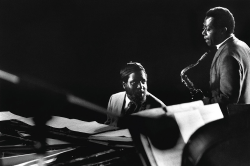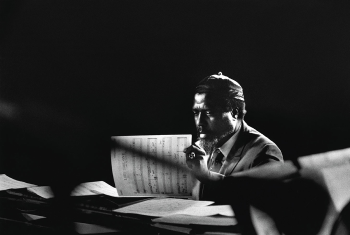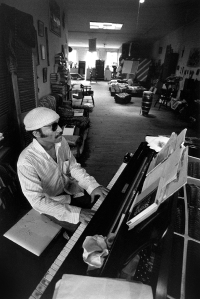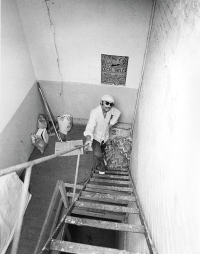.
.
.
…..Jazz in Available Light, Illuminating the Jazz Greats from the 1960s, ’70s, and ’80s is one of the most impressive jazz photo books to be published in a long time. Featuring the brilliant photography of Veryl Oakland — much of which has never been published — it is also loaded with his often remarkable and always entertaining stories of his experience with his subjects.
…..With the gracious consent of Mr. Oakland — an active photojournalist who devoted nearly thirty years in search of the great jazz musicians — Jerry Jazz Musician regularly publishes a series of posts featuring excerpts of the photography and stories/captions found in this important book.
In this edition, Mr. Oakland’s photographs and stories feature pianists Thelonious Monk, Paul Bley and Cecil Taylor.
.
.
All photographs copyright Veryl Oakland. All text excerpted from Jazz in Available Light, Illuminating the Jazz Greats from the 1960s, ’70s, and ’80s
.
You can read Mr. Oakland’s introduction to this series by clicking here
.
.
_____
.
.
© Veryl Oakland

.
Let’s Cool One
Thelonious Monk
Monterey, California
.
.
…..Like all great innovators, Thelonious Monk had his detractors – most notably those who criticized his flat-fingered, hard-edged, percussive attack of the piano, his jagged solo lines, his ever-present dissonant chords, and his unpredictable accents that were dropped in the most unexpected places of a tune.
…..He was a true nonconformist. He didn’t do the intricate runs. While others sought attention with showy sixteenth notes, Monk used space and silence, but still utilized the entire keyboard.
…..Unlike many listeners, I embraced his peculiarities early on. By replaying Monk’s albums over and over, I found myself paying closer attention to what I was hearing. Despite his playing irregularities and unorthodox melodies, his works were always anchored with a solid blues feel. After seeing him live for the first time in 1968 and feeling that infectious swing of his quartet, everything started to fit.
…..I also became particularly enamored with his writing. Some of his compositions were so simple, but in the most remarkable way. Perhaps it was through spending more and more time discovering all I could about Monk, combined with my many years of musical study, that got me to thinking more deeply about what was actually being played on his recordings.
…..Listening to “Blue Monk,” one of the artist’s greatest pieces that today is performed by virtually all jazz players, I kept hearing the basics of, “Santa Claus Is Coming To Town.” Just change a couple of notes at the beginning, I thought, and you’ve got the germ for Monk’s tune. And when I heard “Teo” from the 1964 Columbia album, Monk (not to be confused with Miles Davis’s identically-named, but very different piece, recognizing producer Teo Macero), I immediately thought of the dreamy, time-honored standard, “Yesterdays.” Nothing dreamy about Monk’s take, and thank goodness for that. I continue to love that solid swinger.

Tenor saxophonist Charlie Rouse catches Monk’s attention during a quick break between tunes
…..Monk’s sidemen also cherished their association with the creative genius, clearly recognizing what it meant to be in the moment with such greatness. Charlie Rouse, who served as the leader’s other frontline soloist for more than a decade, knew The Monk Playbook every which way; backward, forward, inside-out, sideways…even, if you will, “Criss-Cross.” Just as with his leader, Rouse never lost sight of the song’s theme, and – more completely than anyone else – easily navigated in, around, and through the pianist’s irregular, angular lines.
…..Everywhere he went – be it in live performances or in the recording studios – Thelonious Monk took special pride in featuring his uniquely identifiable compositions: from his unmistakable jazz standards, such as “‘Round Midnight,” “Straight, No Chaser,” “Ruby My Dear,” and “Evidence,” to such whimsically-named pieces as “Trinkle Tinkle,” “Little Rootie-Tootie,” and “Green Chimneys.” If you were fortunate to be in attendance, you always knew you were in for a genuine treat.
© Veryl Oakland

….
…..Having listened in advance to a sizable number of Monk’s many dozens of compositions, part of the fun of catching him live was to anticipate which tunes he would perform, and then seeing how fast I could name them. If I happened to hear one of his songs I didn’t know, I had to find out what it was, and then go out to buy a new album.
…..One of the great spontaneous flukes for me as a jazz photographer occurred while covering Thelonious Monk and his Quartet at the 1969 Monterey Jazz Festival. From one of the backstage porthole openings – 12-inch circular cut-outs used to observe, but not distract, the performers – I had a telephoto lens focused directly on the pianist. In one fleeting moment between tunes, he raised up one of his title compositions, allowing for a most treasured shot. While it may appear otherwise, there was nothing concocted, nothing staged. For me, that one image captured what was so precious about the man…Monk and His Music.
.
© Veryl Oakland

Thelonious Sphere Monk
piano, composer
Born: October 10, 1917
Died: February 17, 1982
.
.
.
Listen to Thelonious Monk play “Let’s Cool One,” from his 1958 album Misterioso, with Roy Haynes (drums), Johnny Griffin (tenor saxophone) and Ahmed Abdul-Malik (bass), recorded live at New York’s Five Spot Cafe
.
.
.
.
_____
.
.
© Veryl Oakland

.
Expect the Unexpected
Paul Bley
Berkeley, California
.
.
…..In my estimation, he was one of the most comfortable of all people in his own skin. Who else, while barely a teenager, could have hired and managed all the business affairs and payroll of his own band (which included players twice his age), and just a few years later – serving as his accompanist – had the moxie to book the unpredictable genius Charlie Parker for a concert in Montreal, even shepherding him to and from New York to ensure his safe passage?

…..Paul Bley, one of jazz’s finest free thinkers and players – as well as the astute, yet ultimate nonconforming businessman – personified the image of the self-promoter, but without all the fanfare and grandstanding.
…..What originally struck me about the pianist-composer was his quiet assuredness. With an assortment of his trademark pipes, typically never out of reach, the professorial-appearing Bley impressed me with his unassuming, in-charge demeanor that naturally extended throughout his musicianship, personal dealings, and life in general.
…..For me, the joy of being in Paul Bley’s midst was always one of anticipation. Whatever the pianist chose to explore on any given evening might depend on the surroundings, his mood, perhaps the electricity in the room. As a devoted fan, I never knew what was on that night’s musical agenda, which was a good thing. I only knew that it would be fresh, inspiring, and fanciful: completely different from anything I’d heard the last time I’d seen him.



.
…..I also savored each opportunity to be in his company, whether at soundchecks or in the privacy of his dressing rooms. The way he communicated his thoughts was just a natural extension of how he composed and presented his unique offerings to the public. Paul Bley may have been direct and off the cuff in his comments, but after taking it all in, I kind of sat back and marveled at just how cogent, convincing, and well-reasoned they always were.
…..As a photographer, I looked for certain mannerisms and idiosyncrasies that strictly identified this adventuresome innovator. On occasion, Bley would create drama by reaching inside the piano, sometimes muffling the strings with one hand while striking the keys with the other. To help facilitate such moves, to the consternation of certain snobbish writers who considered it an attention-grabbing ploy, he might stack telephone directories on top of the piano bench for an easier reach.
…..A true visionary, Paul Bley maintained success by following his instincts and continuing to stay true to what worked for him. For more than 50 years, he served as a direct influence on the most disparate of musicians, as well as the vibrant, ever-changing jazz scene.
…..As he traversed the globe performing in some of the world’s most elegant halls, a new and ever-growing appreciative public arrived at the same reality that those in the know have recognized for a very long time – the sheer greatness that was Paul Bley.
.
© Veryl Oakland

Paul Bley
piano, synthesizer, composer
Born: November 10, 1932
Died: January 3, 2016
.
.
Listen to a 1999 recording of Play Bley play “When Will the Blues Leave,” with Paul Motian (drums), and Gary Peacock (bass)
.
.
.
_____
.
.
.
.
© Veryl Oakland

.
Loft Headquarters
Cecil Taylor
New York, New York
.
.
…..Writers and critics generally have a hard time interviewing Cecil Taylor. Answers to their questions aren’t always forthcoming, and those which are given often fluster or confound them. For many, conducting an interview with Taylor can be as overwhelming as reviewing one of his marathon performances, occasionally – depending on the venue – running up to two hours or more.
…..A true jazz visionary with deep roots going back to the masters, his well-documented debts to other pianists span a wide-ranging progression of modern music styles dating back to the early 20th century. Included among those who have influenced Taylor are Duke Ellington, Mary Lou Williams, Thelonious Monk, Bud Powell, Horace Silver, even Dave Brubeck. But Cecil’s own playing essentially defies categorization. He is recognized as the outstanding pianist of free jazz, or, as critic Leonard Feather wrote in 1976, “The avant of today’s avant-garde.”

.…..The late 1970s were arguably the most innovative, barrier-breaking, and fruitful times of Taylor’s career. There was the experimental 1976 recording, Nachricht Vom Lande (Message From The Country), at the Moosham Castle in Salzburg with Austria’s eccentric concert pianist Friedrich Gulda, followed the next year by Cecil’s unlikely match-up with pianist Mary Lou Williams at Carnegie Hall, and then his 1979 collaboration with drummer Max Roach. That same year, Cecil startled the jazz community when he appeared on the same stage in three US cities with the premier ballet star, Mikhail Baryshnikov, and ballerina Heather Watts.
…..It was the summer of 1979 when we met formally for the second time, on this occasion in his top fourth floor loft at 96 Chambers Street. Since 1975, this had served as his primary residence and base of operations.

…..I had remembered very clearly the details of my initial face-to-face encounter with Taylor some years earlier – and, the personal letter he sent me following our get-together several months later. At that time, I had accompanied a writer to meet with him at his hotel in San Francisco. The first thing that hit me upon entering his room was the oppressive heat. Cecil, who must have cranked up the thermostat past 90 degrees, nevertheless was attired in wool slacks, a smart, warm jacket, scarf, and cap. Regardless of why he did so, the place was really uncomfortable, and the interview did not go particularly well. After the writer left – and despite the temperature – I suggested that we do some photographs, and he agreed.
…..It was several weeks later that I sent him a couple of complimentary photographs from that session, one of which he decided he wanted used for his album, Cecil Taylor: Live In the Black Forest, recorded by MPS Records in Villingen, Germany.
…..Before engaging in our extended photo shoot in his New York loft, Cecil wanted to share with me a particularly satisfying event that had occurred earlier in the year at the Creative Music Studio in Woodstock; at the time, this facility was considered the foremost study center for contemporary creative music. He had been commissioned by directors Karl Berger and his wife Ingrid Sertso to conduct a seminar and compose a series of pieces for some 40 student musicians at the studio.
…..The program featured the Cecil Taylor Unit (with alto saxophonist Jimmy Lyons, violinist Ramsey Ameen, percussionist Jerome Cooper, bassist Alan Silva, and drummer Sunny Murray), plus members of the Creative Music Studio. Consistent with Taylor’s passion for music, poetry, and dance, the ensemble of instrumentalists completed five of his orchestral pieces, interspersed with segments of interpretive dance performed by the acclaimed danseuse, Diane McIntyre, plus recitation of Cecil’s poetry by noted poet, Thulani Davis.

.

.

Rows of long-playing records and a stereo system were situated along one wall, facing a mattress supported on four 2”x8” slabs of wood which served as bed.
….
…..As with most of Taylor’s efforts during this time, the center for embarking on such a unique production was his fourth floor loft. For Cecil, creating the ideas, composing the scores, and rehearsing with The Unit (or any other group of musicians) just naturally took place in his business and personal living headquarters.
…..The long, one-room loft spread out more than 2,000 square feet. At the street-side end of his quarters sat Cecil’s imposing Yamaha concert grand piano. Getting it there, as he explained, was no small achievement. “(Two adjacent)…windows had to be taken out before movers could hoist the piano by crane to the top floor and place it safely inside. That portion of the move alone cost $600.”
…..Along both walls heading into the interior of the loft was a veritable hodgepodge of paintings, macrame, and fabric art pieces, along with programs, posters, and photographs of himself, ballet stars, and other artists or personalities from previous concerts and events.
…..At the opposite end of the loft separated by a free-standing wall was his kitchen, plus a shower, and dressing area. Wafting throughout the loft was the heady and unmistakable aroma of burning incense.

.

…..Cecil pointed out how the configuration of his living space allowed him to heighten his physical prowess – a critically-important ingredient of his preparation both as an artist and performer. He utilized the long layout of his loft to the fullest, regularly following a strict regimen of exhausting workouts and exercise.
…..Taylor attributed this activity to his long love affair with ballet and dance, a profession he readily admitted he could not have done professionally. Nevertheless, his routines were not unlike those of some of the best dancers on the circuit. “The idea is to use as much of the musculature as possible,” he told me, “and try to keep at least in the same condition (as a ballet star) as much as possible.”
…..Several months earlier, Cecil’s exercise routine proved too intense, costing him a trip to the hospital. A diagnosis of pinched nerves resulted in his being placed in traction for 10 days.
…..For the rest of our time together that day, it was obvious that Cecil was none the worse for wear. Lithe as a cat, he was constantly on the move throughout the quarters as we took photos, even bounding up his metal stairs and through the trapdoor leading to the roof of his loft.
…..Afterwards, Cecil retrieved a couple of glasses from the kitchen and we shared an expensive, exquisitely smooth, mature Cognac with very complex notes. It was the perfect finale, a fitting and most delectable coda.
.
© Veryl Oakland

Cecil Percival Taylor
piano, composer, educator
Born: March 25, 1929
Died: April 5, 2018
and base of operations.
.
Listen to Cecil Taylor play “Jitney No. 2,” a track from his 1975 album Silent Tongues.
.
.
_____
.
.
.
Click here to read the edition featuring Stan Getz, Sun Ra and Carla Bley
Click here to read the edition featuring Art Pepper, Pat Martino and Joe Williams
Click here to read the edition featuring Yusef Lateef and Chet Baker
Click here to read the edition featuring Mal Waldron, Jackie McLean and Joe Henderson
Click here to read the edition featuring Dexter Gordon, Art Farmer and Johnny Griffin
Click here to read the edition featuring Thelonious Monk, Paul Bley and Cecil Taylor
.
Click here to read the edition featuring drummers Jo Jones, Art Blakey and Elvin Jones
Click here to read the edition featuring Monk Montgomery and the jazz musicians of Las Vegas
Click here to read the edition featuring Sarah Vaughan and Better Carter
.
.
.
All photographs copyright Veryl Oakland. All text and photographs excerpted with author’s permission from Jazz in Available Light, Illuminating the Jazz Greats from the 1960s, ’70s, and ’80s
.
You can read Mr. Oakland’s introduction to this series by clicking here
Visit his web page and Instagram
.
.
.

































